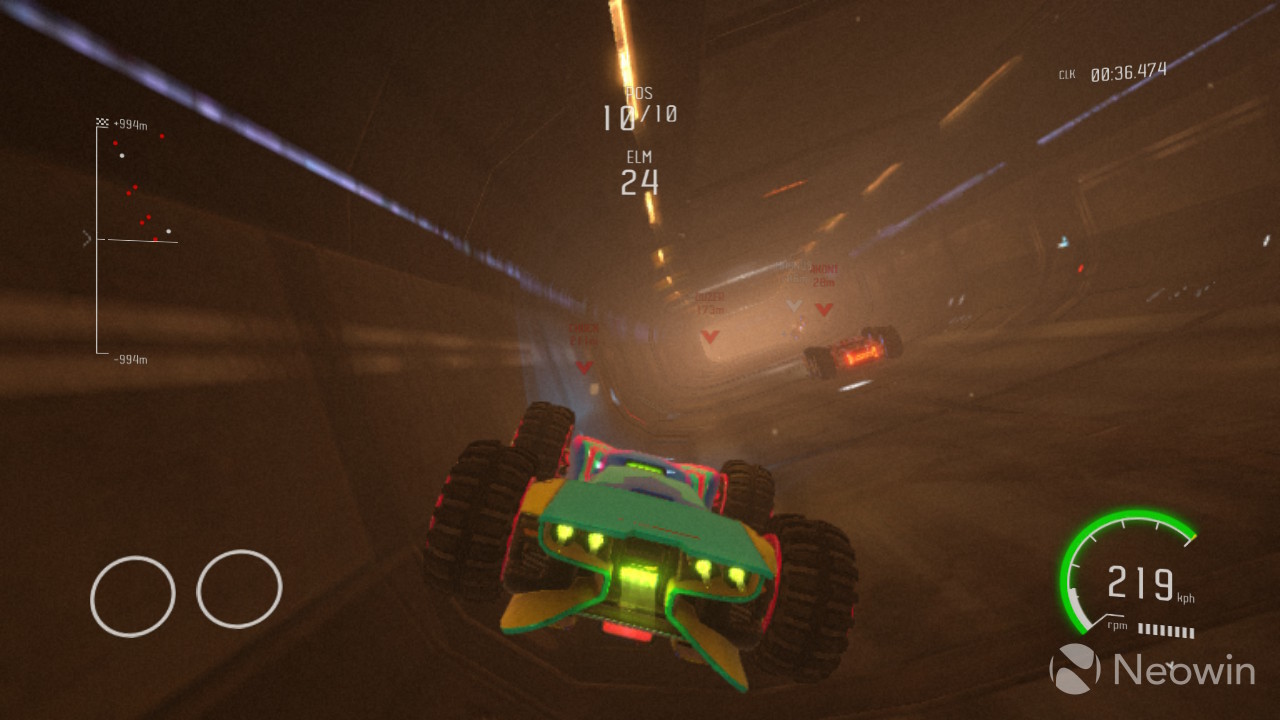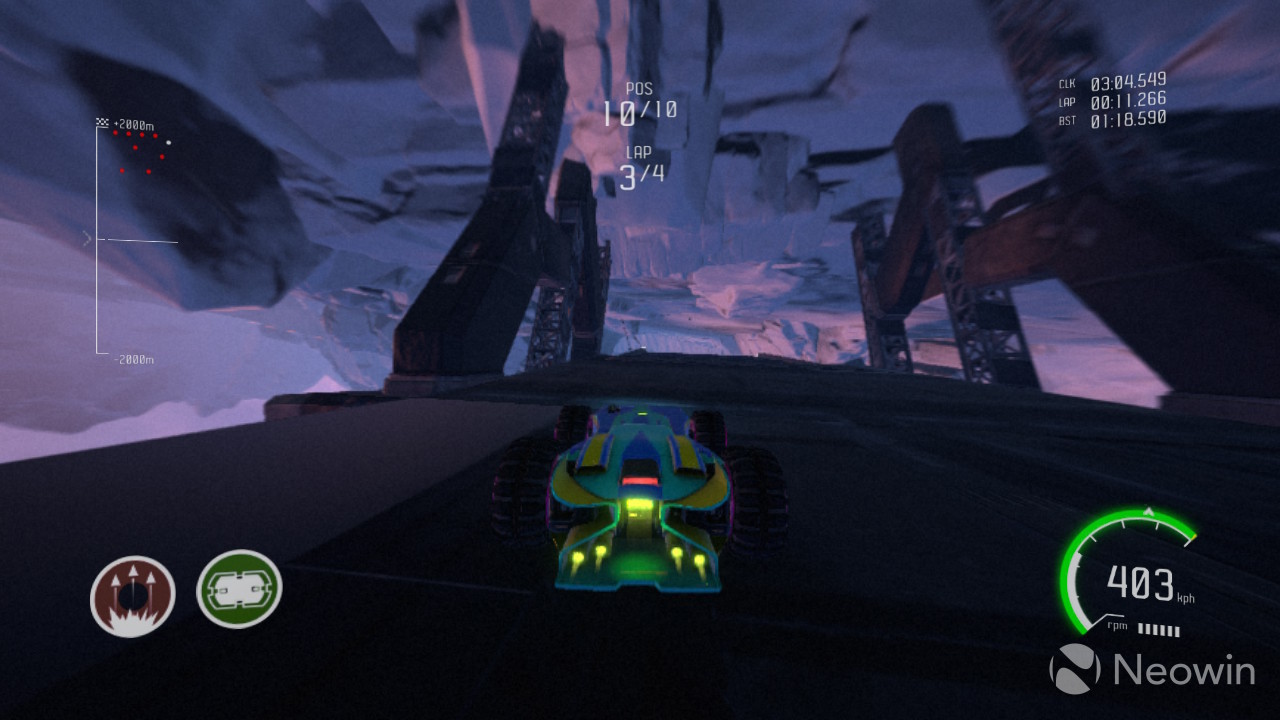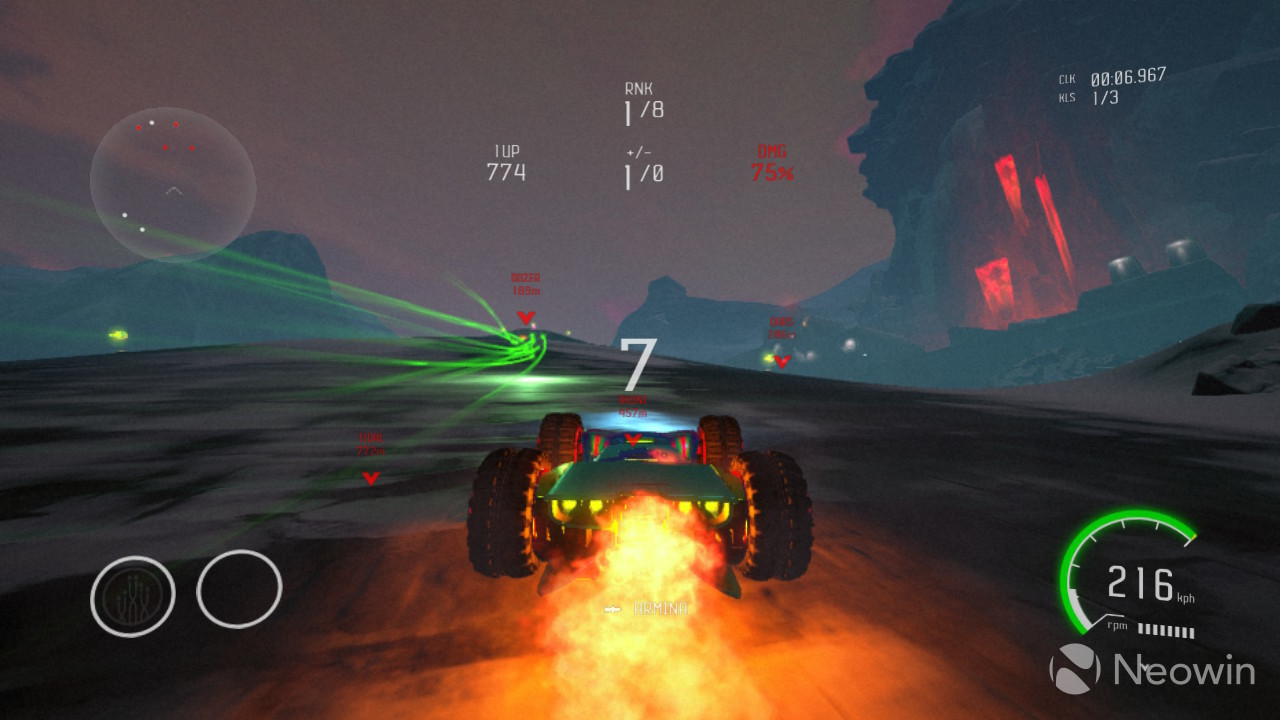Rollcage wasn't a tremendously popular title when it launched in 1999, but it was one of the games that marked my childhood the most. I used to play it with my friends and cousins at the time, and I was always deeply saddened that the franchise died so quickly. Attention to Detail, the game's developer, went bankrupt just a few years after the title was released, and I thought I'd never see a game like that again. So when I heard that there was a team of developers working on a spiritual successor, I was very interested.
GRIP, developed by Caged Element and published by Wired Productions, is an arcade-style racing video game which, much like the titles that inspired it, sets itself apart thanks to the unique nature of the vehicles players can drive. These cars have wheels which are larger than the body of the car, allowing them to be driven even if they’re flipped upside down. They can also drive up walls and on ceilings, which makes for a fairly unique and challenging driving experience. Additionally, weapons and items can be found throughout the game’s courses in order to attack opponents, gain speed, and more. Of course, it’s coming out almost 20 years after the original Rollcage, so there are bound to be a lot of changes to almost every aspect of the game.
Races, battles, and stunts
This starts with the variety of content offered. GRIP greatly expands upon the games that inspired it, and there are now five racing modes, though one of which is a simple time trial mode where you race against your own best time. The other four modes all feature small twists that make each race somewhat different. For example, in normal races, you’ll only have to worry about finishing first, but in ‘ultimate’ races your final position is also determined by how much damage you deal to other drivers.

The scope of video games has grown a lot over the past 20 years, and while GRIP has visibly expanded upon what was offered in Rollcage, it’s hard to consider its 23 tracks a lot. On the Nintendo Switch, where I reviewed this game, Mario Kart 8 Deluxe has 48 race courses, as does the indie title Fast RMX, which is also noticeably cheaper than GRIP. Granted, those tracks are also visibly less complex than the ones found in this title, so there’s certainly a bit of a tradeoff there. Plus, Wired Productions tells me that more tracks and cars will be added via free updates, and one of the 23 tracks in the game was actually added with a day-one patch I received while reviewing the game, and the team has already promised more content (which I'm told will be free), so this is something that will evolve with time.
If you want a little more than races, there are also arena-based modes and a special ‘Carkour’ mode. The former is slightly reminiscent of the battle mode that’s typically included in Mario Kart titles as far as mechanics go. There are a total of five battle arenas, which, again, isn’t a whole lot, but it’s not too bad either. As of right now, the only available mode in arenas is Deathmatch, where you simply attack other drivers as much as possible to get the highest score. Two other modes, Steal the Stash and Time Bomb, are visible in the menu, but can’t actually be played right now, with the game saying they’re ‘coming soon’. Since this indicates they will be enabled in future updates, we can also hope that those updates will bring new arenas as well.

The Carkour mode is inspired by another hit racing game, Trackmania, and you have to make your way through a series of twisted obstacles to get to the end of a course. Other cars aren’t present here, and all of the challenge revolves around your ability to stay on the road and make it to the end, which requires very precise driving. There are a total of 19 tracks in Carkour mode which quickly escalate in difficulty. Despite being challenging, however, these tracks aren’t quite on the same level as some of the insane stages you could play in Trackmania, and I can’t help feeling that there’s some wasted potential in the absence of a track editor in the game, which would have been especially useful in this game mode, possibly giving it hundreds, maybe thousands, of community-created stages, and extending the game’s longevity.
Customization
GRIP also focuses a lot on the ability to customize your cars and even the races themselves. There are 15 different cars in the game, which can be customized with different paint jobs, decals, rims, and wheels to suit your taste. But not only can you change these elements, you can customize almost anything about them too.
Car bodies can have up to three colors depending on the paint job, and each of those can be individually adjusted for hue, saturation, and brightness. The wheel rims can have up to two colors which can be adjusted in the same way, and you can even change the brightness and contrast (though not the hue) of the tires themselves. The decals themselves also have their own set of customizable settings, so there’s no shortage of options and you can make your car look like just about anything you want.

When you start playing for the first time, not many of these options are available, and the way to unlock them is through the progression system in the game. You earn XP by playing (especially if you win) and items are unlocked as you level up. There are plenty of unlockable items, and the system is designed so that you unlock items with almost every time you level up, which makes the game feel a little more rewarding.
Races themselves have a few customizable settings as well, which you can set before you start a race. You can set the number of laps, the number of racers, turn items off or on, change the difficulty level, and more. You can even create tournaments with up to six events - which can be both races and arena deathmatch battles – and customize these settings for each event.
Campaign
GRIP also has a campaign mode, which presents a series of preset challenges that increase in difficulty as you go through it. This means that the customizable settings mentioned above, such as the difficulty level and number of opponents, aren't available here. Instead, they’re adjusted as you progress through the numerous tiers, adding more opponents, increasing the speed and difficulty, and unlocking more weapons.

As you play through each tier, you also develop rivalries with other drivers. Your rivals are the drivers you interact with more often throughout the races by finishing in close positions or attacking and being attacked by them. This basically enables you to call them out in between tournaments, giving you the chance to face them head-to-head for extra XP. Losing these races means you’ll lose XP, though, and you’ll also make your rivals stronger, so you need to be careful. You also have to face your biggest rival at the end of each tier so you can progress to the next one.
There's an issue with the campaign mode which means it doesn't always report your overall position correctly. It seems to be a bit of a hit and miss situation, and I'm not exactly sure what causes it, but sometimes the game will say you're in a different position than you should be based on your previous races. Wired Productions has acknowledged this issue and says a fix is on the way very soon. In the meantime, it shouldn't affect your ability to progress through the campaign.
Racing
GRIP is, in many ways, a bigger and better Rollcage, but the actual racing was what made the 1999 game so much fun, and I’m happy to report that the feeling is still very much present here. Wired Productions says that you can drive cars at up to 767 miles per hour, and if you’re thinking that number is arbitrary, you’re probably right. But this game is very, very fast, and you’ll likely need a bit of an adjustment period to get used to it. The developers seem to know this, and thankfully there’s a setting for the engine power, which adjusts the max speed of the race.

I've mentioned the day-one patch before, and I feel like it's important to mention it here again. Prior to receiving the update, I had a lot of complaints regarding the game's speed. It was very easy to be sent flying at higher speeds and it made racing very hard. Thankfully, the patch didn't just improve the overall look of the game, it seems to have vastly improved the physics in it. Usually, I'd chalk it up to some form of placebo effect, but the difference is just too obvious to be ignored. Races are still very fast, that hasn't changed, but they're much more manageable now, and you won't be flying around aimlessly as much.
Races aren't all about driving though, as you'll also need to use items which can be collected along the courses. There are a total of nine different items, five weapons and four power-ups. Weapons are meant for attacking your opponents directly, sending them flying and spinning, as well as dealing damage if vehicle destruction is enabled. Power-ups can benefit the user by giving them a speed boost, protecting them from attacks, or interfering with other racers' driving. You can store up to two items at the same time, and if you want, you can sacrifice one of them to charge up the other.
For weapons, there's a targeting system that's supposed to help you attack who you want, but due to the way physics work in the game, it's not always guaranteed that you'll hit anyone but yourself. Aside from that, they do add some fun to the races, though you can disable item pickups if you disagree with that.

If you want to do something a little different, the arena modes are also fairly fun. The weapons you usually find during races are the star of the show here, and the focus is on attacking everyone around you. There’s a lot of speed to the cars, so it’s not always easy to get your attacks right, but once you get in the flow, it’s a very refreshing experience compared to the races, and the arenas are at least large enough to accommodate the high speeds with no problems.
Multiplayer
GRIP also offers both local split-screen and online multiplayer modes, but the former is limited to two players on the Switch, while other platforms allow for four. I thought this was interesting since many titles on the hybrid – including Rocket League, Mario Kart 8 Deluxe, and Fast RMX – allow for it, but Wired Productions tells me this is due to the unique physics of the game which make it very hard to develop the feature on the Switch.
Presumably, this is also why the console struggles to keep the frame rate up in this mode, which can feel a little slow at times. This also happens in the single-player mode when there’s a lot of visual effects on the screen. Sadly, this is one of the aspects that wasn't significantly improved by the day-one patch. Though the general appearance of the game, as well as the physics, are noticeably better, the frame rate is still somewhat unstable, and it shows.

Playing in split-screen mode has a couple of major annoyances too. For starters, after every race, you're sent back to the home screen. On the Switch, this disconnects the second player's controller, which then has to be reconnected every time you go back into the split-screen option. Plus, when you're actually playing, a high-pitch sound can sometimes be heard in split-screen mode. There's also a game-breaking bug when customizing your vehicles in split-screen mode; if the second player goes into "Examine mode", which essentially lets them move the camera to look more closely at different parts of the car, there's no way to exit from that view, and you'll be forced to close and re-open the whole game.
As for online, for some reason, I haven't been able to find any matches, even after the game's release, so I can't speak for how well things go in that mode. I reached out to Wired Productions and was told that the Switch community is small at this time. Since the game doesn't support cross-platform play (at least for now), your ability to find online matches will depend on the platform you're on.
Conclusion
I’m a huge fan of the combat racing style that defined Rollcage, and GRIP delivers very nicely on the promise of bringing it back. At $40, it’s only a little cheaper than more mainstream titles that have more content, but GRIP will be receiving updates to add new tracks and cars, and there's a lot of fun to be had in these races. There are some issues here and there, but it's still a worthy investment. And, if you're on Xbox One, the game immediately joined the Xbox Game Pass upon launch, so there's no reason to pass up on this if you have a subscription.
This review was conducted using the Nintendo Switch version of GRIP thanks to a code provided to Neowin by Wired Productions, but the game is also available on Xbox One, PlayStation 4, and PC through Steam. Note that some of the technical issues found in this review may not be reflected on every platform.









3 Comments - Add comment